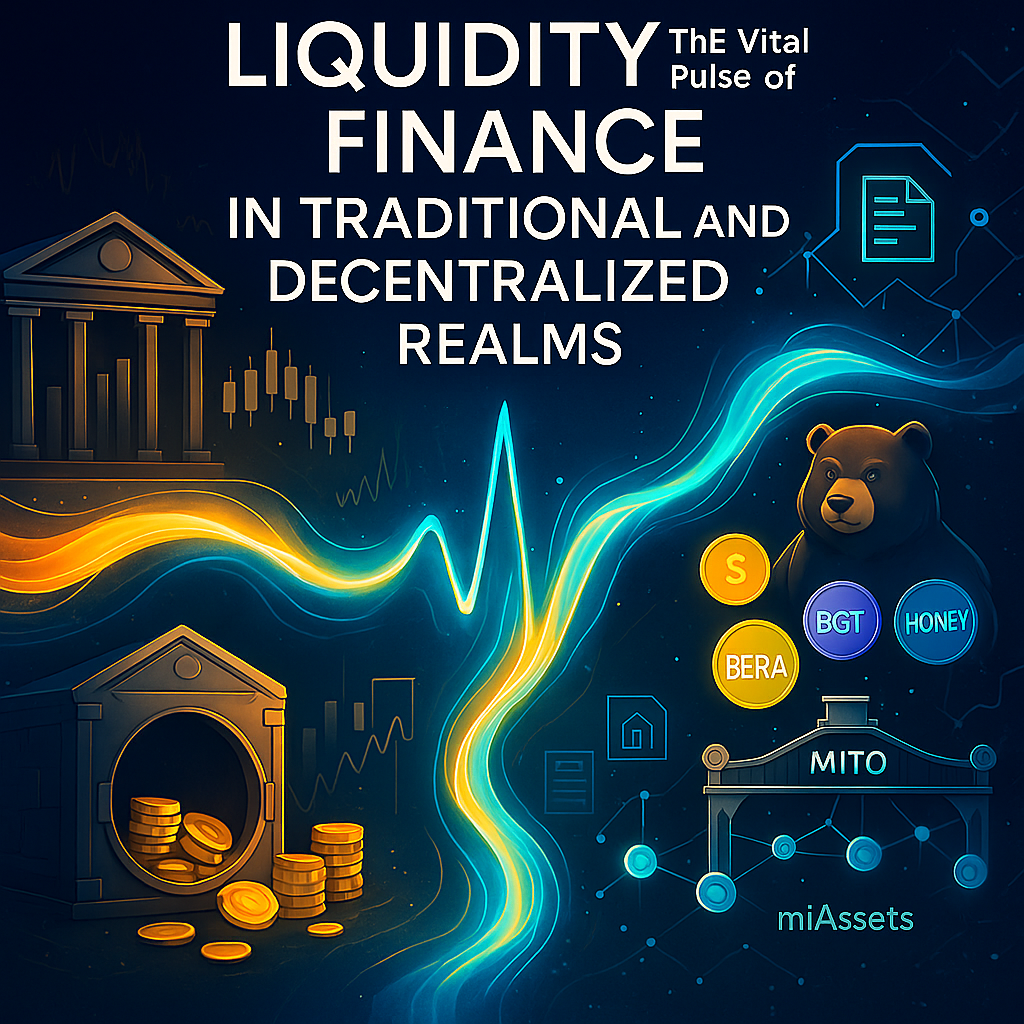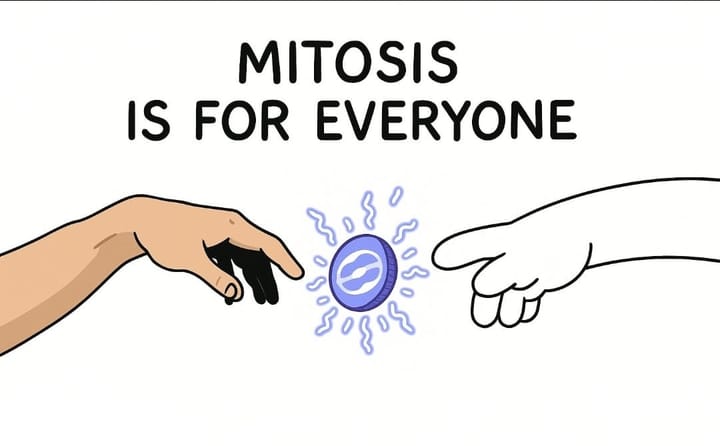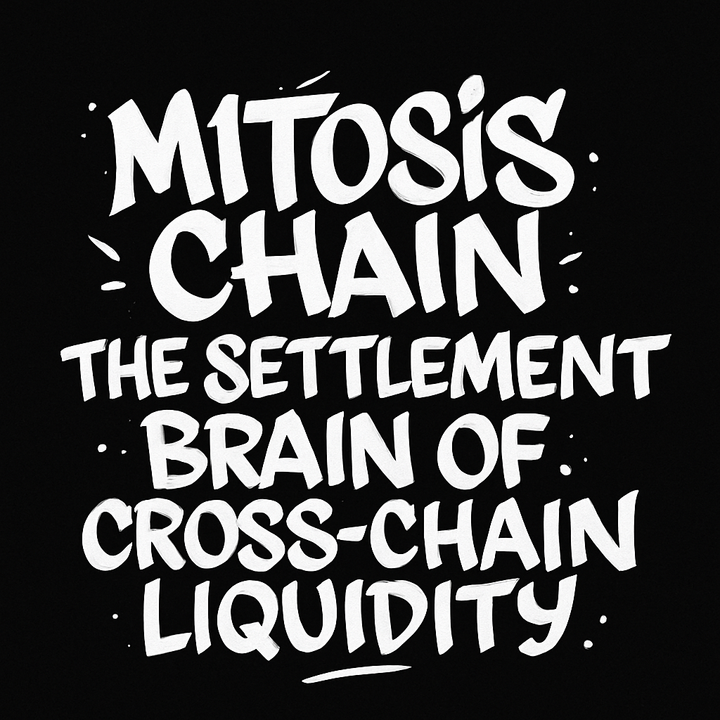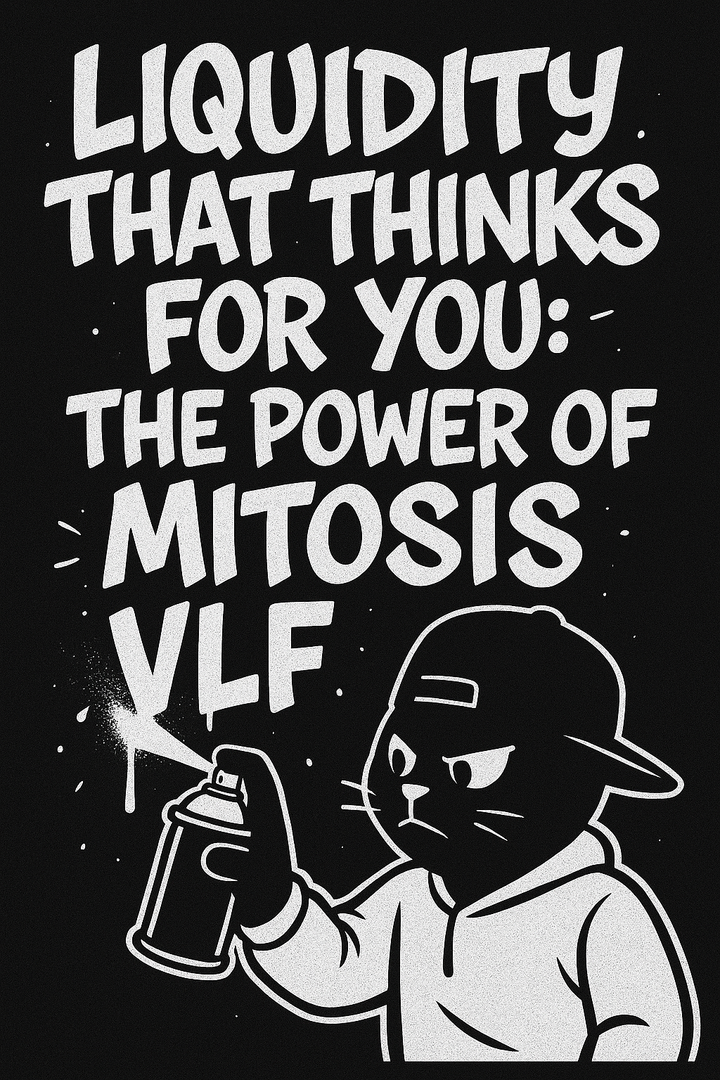Liquidity: The Vital Pulse of Finance in Traditional and Decentralized Realms

Abstract
Liquidity is the lifeblood of any financial system—it keeps markets moving, supports stability, and fuels growth. In both traditional finance (TradFi) and the rapidly evolving world of decentralized finance (DeFi), how liquidity is created, maintained, and utilized is a defining factor. This article takes a closer look at liquidity’s evolving role, from its roots in centralized systems to the emerging blockchain-based models impacting the crypto landscape. We focus on two key innovations: Berachain’s Proof of Liquidity (PoL), which ties liquidity provision directly to network security, and Mitosis’s Programmable Liquidity infrastructure, which aims to bridge fragmented liquidity across chains. By exploring these developments, along with their benefits, challenges, and broader implications, we highlight how DeFi is not just innovating but reimagining liquidity—moving toward a future where it’s always available, everywhere: “ambient liquidity.”
Introduction: Liquidity as the Lifeblood of Finance
Liquidity, often described as the lifeblood of financial markets, dictates how efficiently assets can be bought, sold, or converted without significantly impacting their price (StoneX). Its importance spans traditional global finance, where it ensures smooth transactions and market stability, to the rapidly evolving cryptocurrency sector, where decentralized mechanisms are redefining liquidity provision. As markets become increasingly digitized, two pioneering blockchain projects—Berachain and Mitosis—are addressing liquidity challenges with innovative Layer 1 solutions. Berachain’s Proof of Liquidity (PoL) aligns network security with ecosystem liquidity through a unique tri-token model, while Mitosis’s Programmable Liquidity infrastructure tackles cross-chain fragmentation with Ecosystem Owned Liquidity (EOL) and miAssets. This article analyzes these advancements, comparing their approaches and exploring their potential to shape the future of both decentralized and traditional finance.
Liquidity in Traditional Finance
Defining Liquidity in TradFi
In traditional finance, liquidity refers to the ease and speed with which an asset can be converted into cash without causing significant price changes (StoneX). Highly liquid assets, such as major currencies or blue-chip stocks, can be traded quickly with minimal value loss, while illiquid assets, like real estate or niche investments, may require time or price concessions to sell. Liquidity is critical for market efficiency, enabling rapid transaction execution and reducing risks for participants (ReligareOnline). For financial institutions, liquidity is essential for facilitating client trades, meeting obligations, funding growth, and managing balance sheet fluctuations.
Regulatory Frameworks and Systemic Importance
The 2008 financial crisis reflects liquidity’s systemic importance, revealing the catastrophic consequences of widespread illiquidity. In response, regulators introduced stringent measures like the Liquidity Coverage Ratio (LCR) and Net Stable Funding Ratio (NSFR) in the United States. The LCR ensures banks hold enough high-quality liquid assets to withstand a 30-day stress scenario, while the NSFR promotes stable funding over longer horizons. These regulations highlight liquidity risk—the danger that an institution cannot sell assets quickly enough to meet cash needs without significant losses. This concept is particularly relevant in crypto markets, where volatility and network congestion amplify liquidity challenges.
Table 1: Comparative Overview: Liquidity in Traditional Finance vs. Decentralized Finance
| Feature | Traditional Finance (TradFi) | Decentralized Finance (DeFi) |
|---|---|---|
| Definition & Core Principle | Ease of converting assets to cash without significant price impact. | Ease of swapping/converting crypto assets without significant price impact or delay, often via smart contracts. |
| Primary Sources of Liquidity | Market makers, banks, institutional investors, exchange order books. | Liquidity pools (user-supplied), AMMs, crypto lending protocols, individual traders. |
| Key Mechanisms | Centralized order books, designated market makers, interbank lending. | Automated Market Makers (AMMs), liquidity pools, lending/borrowing smart contracts, on-chain order books (less common). |
| Access & Participation | Often restricted to licensed entities, accredited investors; high barriers to entry for market makers. | Generally permissionless; anyone can provide liquidity or trade (with a crypto wallet). |
| Regulatory Oversight | Highly regulated (e.g., SEC, FDIC, LCR, NSFR) (FDIC). | Largely self-regulated by code and community governance; regulatory landscape evolving and varies by jurisdiction. |
| Transparency | Varies; order books may be public, but ultimate beneficial ownership can be opaque. | High on-chain transparency (transactions/pool balances are public); off-chain components or identities may be private. |
| Transaction Speed & Cost | Can be slow (T+2 settlement) and costly, depending on asset and intermediary. | Varies by blockchain; can be near-instant but subject to network congestion and gas fees. |
| Asset Types Primarily Supported | Equities, bonds, currencies, commodities, derivatives. | Cryptocurrencies, stablecoins, tokenized assets (including some RWAs). |
| Key Risks | Counterparty risk, systemic risk, operational risk, regulatory risk. | Smart contract vulnerabilities, impermanent loss, oracle risk, network congestion, regulatory uncertainty, rug pulls. |
| Innovation Drivers | Regulatory mandates, institutional demand, competition among established players. | Open-source development, community governance, pursuit of capital efficiency, composability, yield generation. |
Table 1: Comparing liquidity mechanisms in TradFi and DeFi.
Decentralized Finance: A New Paradigm
Decentralized Exchanges and Automated Market Makers
Decentralized Exchanges (DEXes) enable peer-to-peer cryptocurrency trading via smart contracts, bypassing traditional intermediaries like banks or brokers (Coinbase). Early DEXes struggled with liquidity due to inefficient on-chain order books, leading to high slippage and limited appeal for large trades. The advent of Automated Market Makers (AMMs) revolutionized DeFi by using mathematical formulas and liquidity pools—crowdsourced token reserves—to facilitate trades algorithmically. AMMs allow anyone to contribute assets to a pool, decentralizing the market-making role and improving efficiency over order book systems.
Liquidity Pools and LP Tokens
Liquidity pools, the backbone of AMM-based DEXes, are smart contracts holding reserves of token pairs (e.g., ETH/USDC) supplied by Liquidity Providers (LPs). LPs deposit tokens in specified ratios and earn trading fees, often supplemented by governance token rewards through liquidity mining or yield farming. In return, LPs receive LP tokens, representing their pool share. These tokens are composable, usable in other DeFi protocols like yield farms or lending platforms, creating interconnected liquidity networks. However, challenges like slippage—price discrepancies during trades—and impermanent loss—value changes in deposited assets—persist, particularly in low-liquidity pools or volatile markets (LiquidityFinder).
Crypto Lending Protocols
Crypto lending platforms allow users to lend assets for interest or borrow against collateral, enhancing liquidity without requiring asset sales. Most loans are over-collateralized, with Loan-to-Value (LTV) ratios dictating borrowing limits. Risks include:
- Market Volatility: Sharp collateral value drops can trigger liquidations, impacting market liquidity during crashes.
- Platform Security: Centralized platforms face hacks, while decentralized ones risk smart contract vulnerabilities.
- Borrower Default: Extreme conditions may render collateral insufficient.
Unlike staking, where assets are often locked, lending offers greater liquidity, though both carry risks tied to market dynamics (Mintos).
Challenges: Mercenary Capital and Systemic Risks
DeFi’s permissionless nature enables rapid capital movement, often termed “mercenary capital,” where funds chase high yields across protocols, leading to volatility. The composability of LP tokens, while enhancing efficiency, introduces contagion risks, where issues in one pool (e.g., exploits or depegging) can trigger cascading liquidations across protocols. These challenges highlight the need for sustainable liquidity models, as seen in Berachain and Mitosis.
Berachain’s Proof of Liquidity
Conceptual Framework
Berachain, an EVM-compatible Layer 1 blockchain built on BeaconKit (Cosmos SDK), introduces Proof of Liquidity (PoL), a consensus mechanism that integrates liquidity provision with network security (Berachain Docs). Unlike traditional Proof of Stake (PoS), where staking competes with DeFi participation, PoL aligns validators, dApps, and users to enhance ecosystem liquidity (Fireblocks). Validators direct block rewards to dApps, fostering capital efficiency and dApp growth.
Tri-Token Model
Berachain uses three different tokens, and each one has a specific job:
- $BERA – This is the main token.
- It’s used to pay for gas (transaction fees), and also to secure the network.
- If you want to be a validator (someone who helps run the network), you must stake between 250,000 and 10 million $BERA.
- Only the top 69 stakers become validators.
- $BGT (Berachain Governance Token) – This is a rewards and voting token, but:
- It can’t be traded or sold.
- You earn it by either:
- Producing blocks as a validator, or
- Staking special “receipt” tokens (from the PoL system).
- You use $BGT to vote on decisions, boost validators, or even redeem it 1:1 for $BERA.
- $HONEY – This is Berachain’s stablecoin.
- It’s designed to stay steady in value and is used mostly in DeFi (decentralized finance) apps.
- It’s over-collateralized, meaning it’s backed by more assets than it’s worth, to keep it stable and safe.
Why use 3 tokens?
Most blockchains just use one or two tokens, but Berachain separates the roles:
- $BERA = power + security
- $BGT = voice + rewards
- $HONEY = money for DeFi
This keeps incentives aligned, reduces conflicts, and gives Berachain a unique twist compared to traditional proof-of-stake (PoS) systems.
Reward Vaults and Incentives
Reward vaults are smart contracts where dApps offer incentives (e.g., native tokens) to attract $BGT emissions directed by validators. Users provide liquidity to dApps, receive receipt tokens, and stake them in vaults to earn $BGT and dApp rewards (Berachain Docs). Validators optimize emissions based on incentive value and liquidity, creating a competitive marketplace tracked by BeraHub.
Benefits
PoL offers:
- dApp Liquidity: Facilitates bootstrapping for new protocols.
- Capital Efficiency: Channels capital into active DeFi, reducing idle staking.
- Network Growth: Creates a symbiotic relationship between the L1 and dApps, attracting users and strengthening tokens.
- Reduced Fragmentation: Centralizes liquidity incentives within Berachain.
Risks
Challenges include:
- Economic Fragility: $BGT premium declines or $BERA inflation could disrupt the PoL flywheel (Berachain Forum).
- Centralization: Limited validator sets (69) and $BGT accumulation may concentrate power.
- Complexity: PoL’s intricate design may deter adoption.
- DeFi Risks: Smart contract vulnerabilities and liquidity crises persist, though audits mitigate some risks.
Mitosis’s Cross-Chain Liquidity Solution
Addressing Fragmentation
Mitosis, a Cosmos SDK-based Layer 1, tackles liquidity fragmentation across blockchains, where siloed capital reduces efficiency. Its infrastructure enables assets to flow across chains, minimizing bridge-related risks and costs.
Ecosystem Owned Liquidity (EOL)
Mitosis’s Ecosystem-Owned Liquidity (EOL) model enables the protocol to collectively manage significant liquidity through user governance, rather than relying on short-term “mercenary capital.” When users deposit assets into Mitosis Vaults, they receive miAssets—programmable tokens representing their share of pooled assets. These assets are governed democratically, with participants voting on how liquidity is allocated. This system fosters stability, predictable yields, and efficient cross-chain liquidity usage, aligning with calls for sustainable and transparent DeFi models.
Infrastructure: M.O.R.S.E and Hyperlane
- The M.O.R.S.E (Mitosis Operations and Rewards for Strategic Engagement) program tackles the classic chicken-and-egg problem in new marketplaces by offering smart incentives. Since supply and demand often depend on each other’s presence, M.O.R.S.E uses $MITO token rewards to lower the cost for protocols launching liquidity campaigns on Matrix. This helps kickstart activity while keeping yields attractive for users. As more protocols join and TVL grows, network effects strengthen, allowing incentives to scale down naturally over time. In short, M.O.R.S.E jumpstarts ecosystem growth and gradually shifts toward sustainable, organic liquidity.
- Hyperlane: Enables permissionless interoperability for miAsset movement, More here.
These components ensure scalable, secure cross-chain functionality.
Objectives
Mitosis aims for:
- Capital Efficiency: Multi-chain liquidity deployment.
- Reduced Volatility: Stable pools via EOL.
- Scalable DeFi: Supports multi-chain strategies and derivatives.
Risks
Challenges include:
- Bridge Security: Morse and Hyperlane are vulnerable to exploits, a common DeFi risk (Chainlink).
- EOL Viability: Balancing protocol-controlled liquidity and decentralization is complex (Zeebu).
Comparative Analysis
Core Philosophies
- Berachain: Focuses on native L1 liquidity via PoL, aligning security and dApp incentives.
- Mitosis: Targets cross-chain fragmentation, unifying liquidity across networks.
Mechanisms
- Berachain: User-provided liquidity directed by validators and $BGT emissions.
- Mitosis: EOL through community centric governance combined with user-supplied liquidity, spreads liquidity across DeFi projects and chains represented by miAssets.
Tokenomics and Governance
- Berachain: Tri-token model ($BERA, $BGT, $HONEY) with $BGT-driven governance.
- Mitosis: Mitosis uses MITO as its core token, gMITO for governance and rewards that is unlocked by staking MITO, LMITO is also a reward token that gets unlocked overtime with governance participation, and miAssets to represent user liquidity across the ecosystem. More here.
Scalability, Security, Interoperability
- Berachain: Scalable via CometBFT, secure through $BERA staking, EVM-compatible with potential IBC integration.
- Mitosis: Scalable via Tendermint, secure via MITO staking, with strong interoperability via Hyperlane.
Table 2: Feature Comparison: Berachain vs. Mitosis
| Feature | Berachain | Mitosis |
|---|---|---|
| Core Concept & Primary Goal | Consensus mechanism integrating liquidity provision with network security and dApp growth. | L1 infrastructure for unifying fragmented cross-chain liquidity and enabling efficient capital deployment. |
| Target Liquidity Problem | Incentive misalignment in PoS; bootstrapping liquidity for dApps on its own L1. | Liquidity fragmentation across multiple blockchains; inefficient cross-chain capital utilization. |
| Consensus Mechanism | Proof of Liquidity (PoL), an extension of PoS. | Expected to be PoS (Cosmos SDK based); specific consensus details for Mitosis L1 not fully elaborated beyond MITO staking. |
| Key Token(s) & Roles | $BERA (gas/staking), $BGT (governance/rewards - non-transferable), $HONEY (stablecoin). | MITO (L1 security/staking, governance, value capture, liquidity incentives), miAssets (tokenized deposited liquidity). |
| Liquidity Incentive Model | $BGT emissions directed by validators to reward vaults based on dApp incentives ("bribes"). | Yield from cross-chain deployment of miAssets; MITO token incentives; benefits of EOL (stability, potentially shared revenue). |
| Liquidity Ownership Model | User-provided liquidity, heavily directed and incentivized by the core protocol. | Ecosystem Owned Liquidity (EOL) - significant portion owned/controlled by the protocol; supplemented by user deposits (miAssets). |
| Cross-Chain Focus & Mechanism | Primarily focused on its internal ecosystem; potential for IBC via Cosmos SDK. | Core focus; uses Morse bridge and Hyperlane for miAsset transfer and interoperability across chains. |
| Governance Approach | Via non-transferable $BGT token earned through participation. | Via MITO token staking and holding. |
| Primary Benefit Proposition | Deep, sustainable native liquidity for its dApp ecosystem; aligned L1/dApp incentives. | Unified cross-chain liquidity; enhanced capital efficiency across multiple networks; potentially more stable liquidity through EOL. |
| Key Associated Risks | Economic model fragility (BGT premium, BERA inflation), validator centralization, PoL complexity. | Cross-chain bridge security, EOL viability and centralization, L1 adoption hurdles, MITO tokenomics sustainability. |
Table 2: Comparing Berachain’s Proof of Liquidity and Mitosis’s Programmable Liquidity.
Future of Liquidity Solutions
Evolution from AMMs
AMMs, starting with constant product formulas (e.g., x*y = k$), democratized liquidity but faced limitations like impermanent loss and slippage. Advanced AMMs like Uniswap v3 and Curve Finance introduced concentrated liquidity and dynamic fees, improving efficiency. Berachain and Mitosis represent a further leap, embedding liquidity into L1 consensus or cross-chain infrastructure.
Liquidity-as-a-Service (LaaS)
LaaS leverages aggregation and automation to provide liquidity to dApps and exchanges, enhancing efficiency and stability (AlphaPoint). Berachain offers LaaS within its ecosystem via PoL, while Mitosis provides cross-chain LaaS through EOL and miAssets. Traditional institutions are also exploring crypto liquidity services, signaling convergence (Finextra).
Programmable Liquidity and Institutional DeFi
Programmable liquidity, as seen in Mitosis or Balancer v3’s Boosted Pools and Hooks, supports institutional needs for control and efficiency. These features enable dynamic fees, rebalancing, and compliance, though regulatory hurdles like KYC/AML persist.
Tokenization of Real-World Assets (RWAs)
RWA tokenization, projected to reach $16 trillion by 2030, enhances liquidity for illiquid assets like real estate. Berachain and Mitosis could support RWA markets by providing deep or cross-chain liquidity, making tokenized assets viable financial instruments (Nansen).
Financial Market Infrastructure (FMI) Parallels
DeFi’s liquidity solutions parallel TradFi’s efforts to address fragmented liquidity in cross-border payments. Blockchain-based FMIs could reduce settlement times and costs, with Mitosis’s cross-chain model mirroring TradFi’s push for integrated liquidity (OMFIF) (World Economic Forum).
Conclusion
Liquidity remains the cornerstone of financial systems, and its evolution from TradFi to DeFi reflects a quest for efficiency and stability. Berachain’s PoL and Mitosis’s Programmable Liquidity address critical challenges—misaligned incentives and cross-chain fragmentation—through innovative L1 designs. While promising, these models face risks like economic fragility, centralization, and bridge vulnerabilities. Their successes and shortcomings will shape future protocols, potentially combining consensus-driven, protocol-owned, and cross-chain solutions. The vision of “ambient liquidity”—where liquidity is seamless, efficient, and universally accessible—requires continued innovation in security, interoperability, and incentives. Stakeholders must collaborate to balance innovation with prudence, ensuring robust, inclusive financial markets for both DeFi and TradFi.
References
- AlphaPoint. Liquidity as a Service in Crypto: What It Is and How It Benefits Crypto Markets, https://alphapoint.com/blog/liquidity-as-a-service/
- Berachain Docs. What is Berachain? https://docs.berachain.com/learn/
- Berachain Forum. PoL V1.1 - Bera in Control - Proposals - Berachain General. https://forum.berachain.com/t/pol-v1-1-bera-in-control/107
- Chainlink. Seven Key Cross-Chain Bridge Vulnerabilities Explained. https://chain.link/education-hub/cross-chain-bridge-vulnerabilities
- Coinbase. What is a DEX? https://www.coinbase.com/learn/crypto-basics/what-is-a-dex
- Cointelegraph. DeFi must ditch hype for sustainable liquidity, https://cointelegraph.com/news/polygon-ceo-calls-for-sustainable-defi-over-hype-driven-liquidity
- CryptoSlate. Berachain launches Proof of Liquidity to redefine block rewards distribution. https://cryptoslate.com/berachain-launches-proof-of-liquidity-to-redefine-block-rewards-distribution/
- DefiLlama. Mitosis. https://defillama.com/protocol/mitosis
- DWF Labs. Market Making vs. Liquidity Provision in Crypto Explained. https://www.dwf-labs.com/news/market-making-vs-liquidity-provisioning-in-crypto-what-is-the-difference
- Finextra. Crypto Liquidity Services Explained: By Retired Member. https://www.finextra.com/blogposting/27588/crypto-liquidity-services-explained
- Fireblocks. What is Berachain and Proof of Liquidity? https://www.fireblocks.com/blog/what-is-berachain-and-proof-of-liquidity/
- Infosys. How asset tokenization unlocks liquidity in capital market. https://www.infosys.com/iki/perspectives/asset-tokenization-unlocks-liquidity.html
- LiquidityFinder. How do crypto liquidity pools work?https://liquidityfinder.com/insight/liquidity/how-do-crypto-liquidity-pools-work
- Mintos. Crypto lending: How to earn passive income with your digital assets. https://www.mintos.com/blog/crypto-lending/
- Nansen. Real-World Asset Tokenization Explained. https://www.nansen.ai/post/real-world-asset-tokenization-explained
- OMFIF. Public crypto networks as financial market infrastructures. https://www.omfif.org/2025/03/public-crypto-networks-as-financial-market-infrastructures/
- Safeheron. What is Proof of Liquidity and How Does It Work. https://safeheron.com/blog/proof-of-liquidity-and-how-it-works/
- Sovryn. Understanding Liquidity and LP tokens. https://wiki.sovryn.com/en/technical-documents/amm/Liquidity-and-LP-Tokens
- StoneX. Liquidity Definition. https://www.stonex.com/en/financial-glossary/liquidity/s/
- World Economic Forum. How to create the financial market infrastructures of the future. https://www.weforum.org/stories/2025/01/financial-market-infrastructures-innovation/
- Zeebu. The Rise of Protocol-Owned Liquidity: A Sustainable Future for DeFi. https://www.zeebu.com/blog/protocol-owned-liquidity-explained



Comments ()